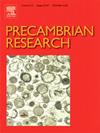Petrogenesis and mineralization potential of spinifex komatiitic basalts in the Bradley Peak greenstone terrane, Wyoming Province
IF 3.2
2区 地球科学
Q2 GEOSCIENCES, MULTIDISCIPLINARY
引用次数: 0
Abstract
Komatiitic volcanic rocks are important hosts of Ni sulfide mineralization and record early Earth evolution; however, those in the well-studied Archean Wyoming Province have received little attention. Here, we elucidate the timing and petrogenesis of the Bradley Peak komatiitic volcanic rocks using field and textural observations, geochronology, and geochemistry. Detrital and igneous zircon U-Pb ages for two samples from previously undated units support published age determinations, placing the eruption age at 2.72 Ga. Stratigraphy of the volcanic flows was mapped and 36 samples including cumulates, greenschists, and spinifex-textured rocks were collected. Whole-rock geochemistry was used to classify the spinifex-textured samples as Al-undepleted komatiitic basalts (11–17 wt% MgO). Platinum-group element concentrations (n = 25) are like those in global Al-undepleted komatiitic basalts, and PGE/Ti ratios do not indicate the volcanic flows likely host sulfide mineralization. Initial εNd values of −0.5 to +4.7 (n = 16), indicate that these lavas were derived from a depleted mantle source and have negligible evolved crust contamination. The primary magma to the komatiitic basalt flows is estimated to have had 19 wt% MgO and be derived from ∼15 to 25 % mantle partial melting at 3–4 GPa. Trace element chemistry and thermodynamic modeling suggest the primary melt assimilated local banded iron formation. Although the Bradley Peak komatiitic basalts do not contain positive evidence of magmatic sulfide deposits, depleted Au in the flows suggests they could be source rocks for nearby orogenic gold deposits.
怀俄明布雷德利峰绿岩中刺状科马长质玄武岩的成因及成矿潜力
科马岩质火山岩是镍硫化物成矿的重要宿主,记录了地球早期演化;然而,那些在被充分研究过的太古代怀俄明州的化石却很少受到关注。在此,我们利用野外和结构观测、地质年代学和地球化学资料阐明了布雷德利峰科马提岩火山岩的年代和岩石成因。两个样品的碎屑和火成岩锆石U-Pb年龄支持已发表的年龄测定,将喷发年龄定为2.72 Ga。绘制了火山流地层学图,采集了堆积岩、绿片岩和棘状纹理岩等36个样品。利用全岩地球化学方法将其分类为未贫铝科马提岩(11-17 wt% MgO)。铂族元素浓度(n = 25)与全球未贫铝科马长岩玄武岩相似,PGE/Ti比值不表明火山流可能存在硫化物矿化。初始εNd值为- 0.5 ~ +4.7 (n = 16),表明这些熔岩来源于枯竭的地幔源,演化的地壳污染可以忽略不计。据估计,马马岩质玄武岩流的原始岩浆MgO含量为19 wt%,来自于3-4 GPa的地幔部分熔融~ 15% ~ 25%。微量元素化学和热力学模拟表明,初生熔体吸收了局部带状铁的形成。虽然布雷德利峰科马长岩玄武岩不含岩浆硫化物矿床的确凿证据,但流中的贫金表明它们可能是附近造山带金矿床的烃源岩。
本文章由计算机程序翻译,如有差异,请以英文原文为准。
求助全文
约1分钟内获得全文
求助全文
来源期刊

Precambrian Research
地学-地球科学综合
CiteScore
7.20
自引率
28.90%
发文量
325
审稿时长
12 months
期刊介绍:
Precambrian Research publishes studies on all aspects of the early stages of the composition, structure and evolution of the Earth and its planetary neighbours. With a focus on process-oriented and comparative studies, it covers, but is not restricted to, subjects such as:
(1) Chemical, biological, biochemical and cosmochemical evolution; the origin of life; the evolution of the oceans and atmosphere; the early fossil record; palaeobiology;
(2) Geochronology and isotope and elemental geochemistry;
(3) Precambrian mineral deposits;
(4) Geophysical aspects of the early Earth and Precambrian terrains;
(5) Nature, formation and evolution of the Precambrian lithosphere and mantle including magmatic, depositional, metamorphic and tectonic processes.
In addition, the editors particularly welcome integrated process-oriented studies that involve a combination of the above fields and comparative studies that demonstrate the effect of Precambrian evolution on Phanerozoic earth system processes.
Regional and localised studies of Precambrian phenomena are considered appropriate only when the detail and quality allow illustration of a wider process, or when significant gaps in basic knowledge of a particular area can be filled.
 求助内容:
求助内容: 应助结果提醒方式:
应助结果提醒方式:


